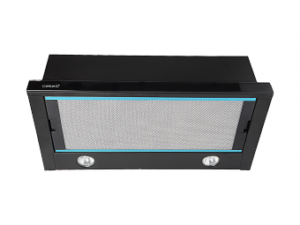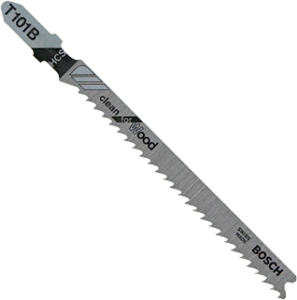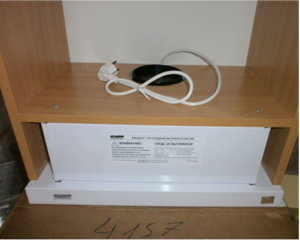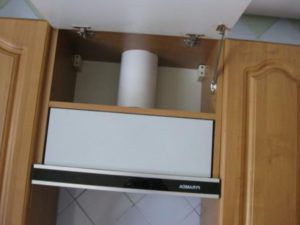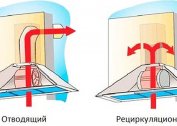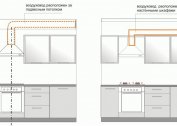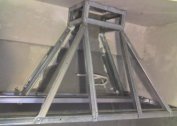Modern built-in appliances are an ideal solution for those who want to simultaneously preserve the appearance of the interior and get additional functionality and amenities. A very popular category of such appliances include built-in cooker hoods, which are mounted directly in a cabinet located above a gas or electric stove. To install such a device correctly, in some cases a lot of skilled work will be required. In other cases, the installation is relatively simple.
Dimensions and related problems
The modern market offers many options for the integrated kitchen hood, of different widths and depths (the area occupied by the surface of the lower part of the cabinet). Depending on existing furniture, several situations may arise:
- the dimensions of the integrated hood are wider than the dimensions of the cabinet. In this case, the help of qualified furniture makers will be required to modify the walls of adjacent cabinets, to preserve the mechanics of door movement;
- the dimensions of the integrated hood are smaller than the dimensions of the cabinet. In this case, you can do it yourself if you choose the type of appliance.
Another subtlety of choosing a built-in hood is the shape of its body. All modern models have a rectangular configuration, so it is relatively easy to mount in a cabinet.
Older options may have a significant protrusion in the duct area or even a rigid duct, which is planned to be placed close to the wall. However, the installation of all models can be made subject to certain rules.
What tools and materials will be needed for installation
Consider an almost ideal option when the hood is installed in a cabinet, the distance between the walls of which is greater than or equal to the landing dimension of the built-in equipment, which is designed to be attached to the inner shelf. In this case, to carry out the work you will need:
- the marking tool is a pencil, however, the practice with chipboard shows that a 0.5 mm marker is better;
- tape measure and carpentry;
- wood drill with a diameter of 10 mm;
- jigsaw and wood saw type CleanWood with a scan of the teeth inside the blade;
- in the case of a round duct, a saw for a jigsaw, specially designed for curved cuts, with a straight tooth and a small blade width, will not be superfluous;
- screwdriver and bit works for work with confirmations;
- four plastic single corners;
- awl;
- screws size 3.5 × 16, chipboard, white;
- any waterproof polymer glue (dragon, primus, contact).
A cabinet design with swing doors will be considered.
It is immediately worth noting that installing the integrated hood in a cabinet with hinged doors may require the transfer of hinges. Such work can be done independently, however, the article will not give advice on this stage, since the type of hinge, the dimensions of the seating recesses, as well as the specific distances at which the paws of the fittings are mounted, will not depend on the design of the door.
- CleanWood Saw
- Saw for curly cuts
Stages of work
To install the built-in hood in the cabinet, you will need:
- remove the entire bottom surface or cut a hole in it of the required geometric dimensions, where the appliance will be installed;
- dismantle the middle shelf and drill holes for the plant inside the electrical connection cable;
- cut the necessary holes in the parts of the chipboard for the passage of the duct, mark the fastening of the built-in hood;
- fix all the elements in the cabinet: built-in hood, shelf, doors.
We will consider all operations sequentially.
Work with the bottom surface of the cabinet
To remove a part, just unscrew the side confirmations. First, you need to expand the back wall, which is attached to the part made of chipboard. This is usually done using staples, however, in handicrafts, nails or screws may be used. After the rear wall is expanded, the side fasteners are removed and the lower part of the cabinet is removed, which does not hold back anything.
If you need to cut a hole of the right size, which does not occupy the entire bottom area of the cabinet, you should follow several requirements:
- the hole should be cut so that the body of the integrated hood fits close to the front of the cabinet, not the back. This will allow not to disassemble the structure;
- the size of the cut-out part is marked with a marker and carpentry corner;
- holes with a diameter of 10 mm are drilled so that their centers are clearly in the corners.
After that, the hole is cut. In practice, it’s enough not to disassemble the cabinet, just remove it from the wall, dismantle the doors (for further convenience working with the shelf), turn over and do all the work on the floor. The following video demonstrates the work process.
A little trick. An electric jigsaw with a coarse-toothed wood saw and laminated chipboard is an ungrateful combination. When a saw is used with a direct direction of the tooth (bevel up, detonation of the material from below, cut when the saw moves up), chips are formed on the upper side of the plate on the side of the cut line. This is a great place to get moisture and destroy chipboard. You can do three ways. In the first case, the end surface and areas of chips are coated with waterproof glue. Surface defects will be hidden if the built-in hood design has a side. In the second case, you can take a saw with a back tooth (cutting is done when the cutting tool moves down). In this embodiment, chips will be inside the cabinet. However, the best way is to delve into the material along the cut line with a strong knife to a depth of 2-3 mm. Then, accurately leading the saw with a straight tooth close to the formed line, you can avoid the appearance of chips. The cutting tool should be located on the side of the part to be removed.
Dismantling the middle shelf
Depending on how the installation is made, to remove the middle shelf, it may be quite simple to remove it from the supports or unscrew the side confirmations. In the most neglected cases, when it comes to handicrafts, it may be necessary to expand the back wall, which the “homegrown” masters “nail for guarantee” are nailed to the middle shelf with brackets or nails.
After dismantling the middle shelf, holes are drilled for cable passage. For this, a wood drill with a diameter of 10 mm is used. The option with a hole is much neater and more attractive than cutting the grooves on the back of the shelf, since it allows you to better protect the cable passage area from moisture with the help of linings.
Air inlet holes
The middle shelf and the upper must be modified so that the installation of the duct is possible. Openings for air passage are made by the following method:
- a rectangle or circle is marked, depending on the type of duct;
- if a rectangular passage is required, holes in each of the corners are drilled according to the rules described above to remove part of the lower cabinet shelf;
- For a circular duct zone, one 10 mm hole is sufficient for the saw to enter.
The holes are cut with a jigsaw in compliance with one of the tricks described above.After that, the end of the chipboard at the place of cut is carefully coated with polymer glue to protect it from moisture.
The next step is the marking of the mounting of the built-in hood. In the simplest case, the removed middle shelf with an already cut hole for the duct is applied to the body, after which, with the help of an awl, punctures are made in the place of the future location of the screws.
Installation of all elements in a cabinet
Installing a built-in hood in a cabinet always involves shifting the middle shelf. To place it where necessary, you need single plastic corners. Working with such fasteners is simple and affordable even for beginners. To minimize the level of errors during placement, you need to follow a simple technique:
- the corners are screwed first to the shelf, all four;
- the shelf is installed in place, it is convenient to do this by placing the cabinet flat on the back with the flat wall
- with the help of an awl, a place for screws is punctured on the side wall;
- corners are fixed with zero offset of the shelf.
After that, you can mount the hood using self-tapping screws, which are screwed into pre-chopped recesses. The following video demonstrates the work process.
Shutdown
The last stage is the final assembly of the cabinet and the installation of doors. In practice, most often the design, where the cabinet body is assembled together, the middle shelf with a built-in hood, is hung in its regular place. After that, the duct is mounted, and the last step - the doors are hung.
